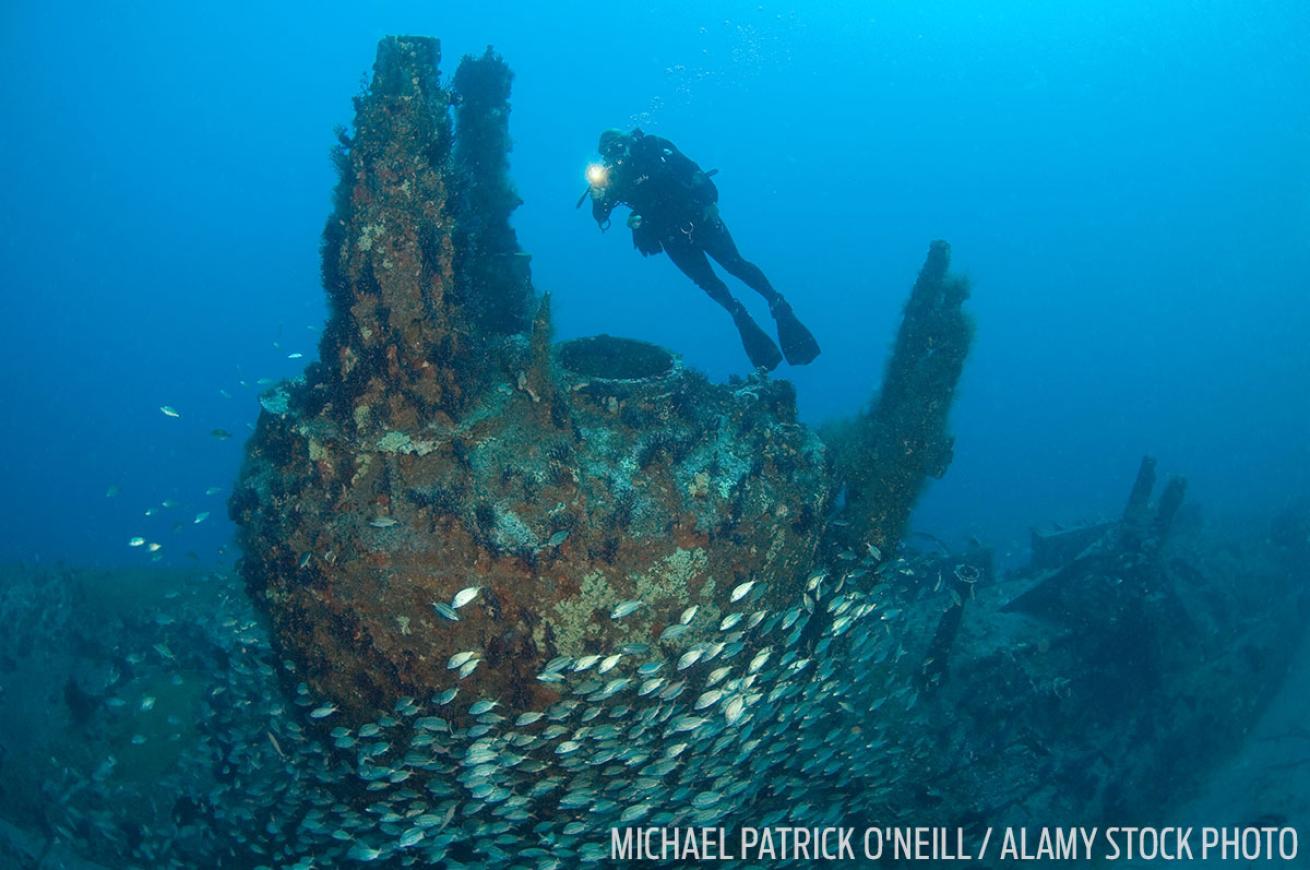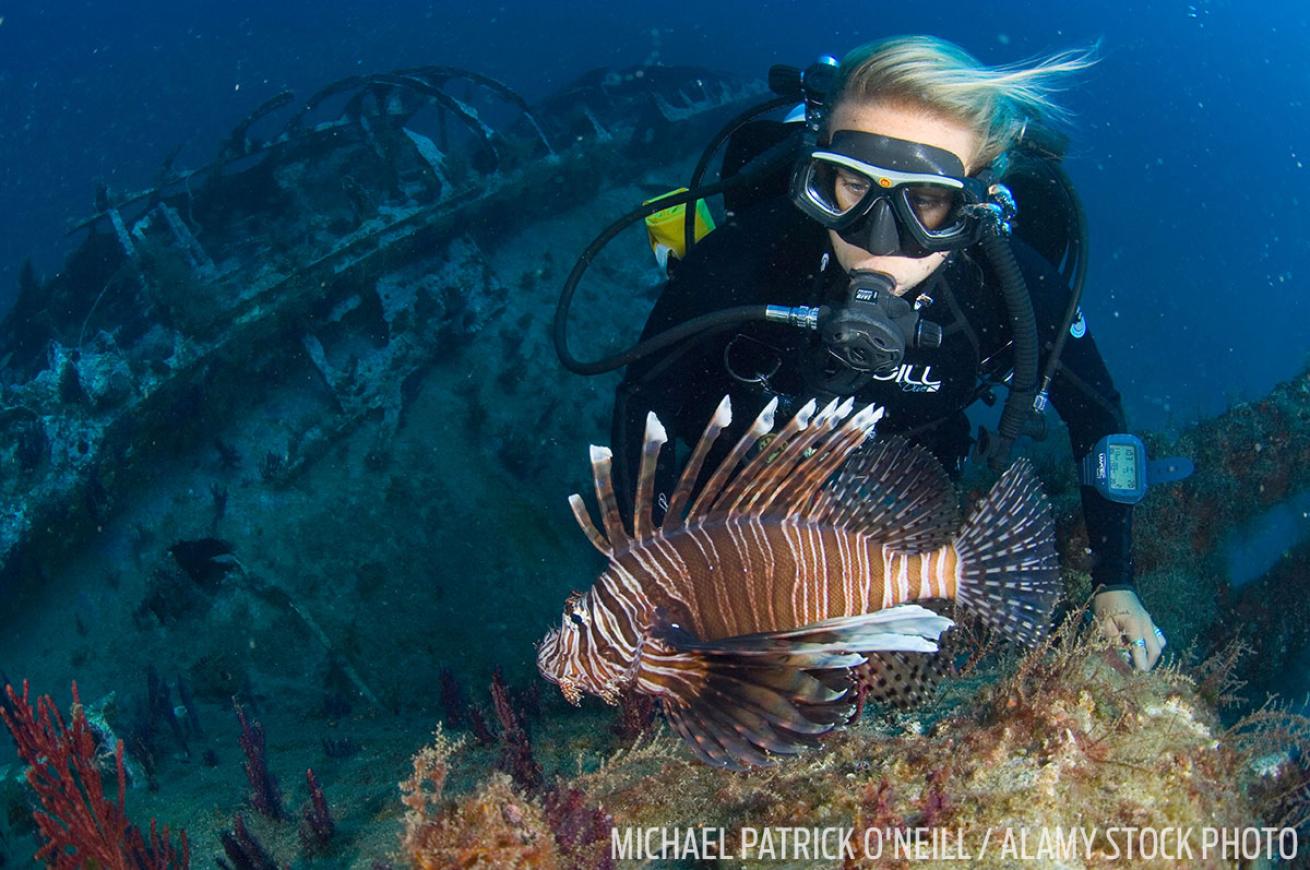History of North Carolina's U-352 Shipwreck
The remains of this German submarine offer scuba divers a place to come face to face with World War II history and serve as a reminder that the conflict came much closer to home than most Americans realize.

Michael Patrick O'Neill / Alamy Stock PhotoThis German submarine sank of North Carolina in 1942.
During World War II, German U-boats prowled the East Coast of the United States, looking for unwary ships. U-352 was one such submarine, but in its efforts to litter the seafloor with shipwrecks, it picked a fight it couldn’t win. In the end, its only addition to the Graveyard of the Atlantic was itself.
History of the U-352
The U-352 is a type VIIC U-boat built by Flensburger Schiffbau-Gesellschaft in Flensburg, Germany in 1941. According to online U-boat database uboat.net, U-352 was launched on May 7, 1941, and commissioned on August 28, 1941.
According to a Navy report from the interrogation of the U-352’s crew, the submarine was equipped with an 8.8 cm cannon and a 2 cm anti-aircraft gun and carried 14 torpedoes during its last cruise. German crewmembers told their captors that their vessel belonged to the 3rd U-Boat Flotilla based out of La Pallice, France.
The boat was under the command of Hellmut Rathke, who had a reputation for being a stern disciplinarian. Rathke came into active duty in 1935 and had served on a number of various surface vessels prior to taking command of U-352 and its complement of 46 men.
One of the submarine’s crewman, Heinz Karl Richter, said in an interview with Discovery Channel that Rathke was obsessed with receiving a Knight’s Cross medal for sinking 100,000 tons’ worth of enemy ships. This obsession would lead to a recklessness that would doom the U-352.
After being commissioned, the crew spent five weeks testing and running drills in the Baltic Sea and performed at least one tactical exercise in Kiel, Germany. U-352 then returned to Flensburg for minor repairs and adjustments. The crew then returned to Kiel to take on torpedoes and provisions in mid-January before beginning their first war cruise.
U-352 didn’t sink a single ship during that first cruise. At one point Rathke prepared to attack a steamer, but abandoned it when four corvettes appeared. The escaping submarine was rocked by depth charges, but took no damage. Aircraft would attempt to attack the U-boat off Iceland, but were unsuccessful.
According to the report, while en route to St. Nazaire, France, the crew fired four torpedoes at a destroyer, but missed. The ship didn’t counterattack, and was presumably unaware of the attack.
The boat reached St. Nazaire during the first week of March where it was cleaned and inspected before departing on its second patrol.
U-352 left for the United States at the beginning of April. It cruised at a slow speed, and crewmen reported that they had been able to sunbathe on deck. The crew was constantly under threat of patrolling aircraft. Once, the sub was spotted and had two bombs dropped on it, but escaped without damage.
During their later interrogation by the US Navy, the German crewman would not admit to seeing the coast of the United States, but they were able to tune into American radio programs. According to the report, “they liked jazz.”
The crew made a number of unsuccessful attacks. But despite a total of seven or eight torpedoes being fired during this period, U-352’s crew did not sink a single vessel. On May 9, 1942, the U-boat would try once more to sink a ship, but this attempt would be its last.
The Sinking of U-352
Around four o’clock in the afternoon on May 9,1942, U-352’s crew came across what they thought was a merchant vessel; Rathke eagerly ordered a torpedo be fired at the ship. Unfortunately for the Germans, the torpedo missed. Even more unfortunate for them, the ship they had fired upon was not a merchant ship, but the Coast Guard cutter Icarus.
Realizing his mistake, Rathke brought his boat to the sea floor, hoping to avoid Icarus’ anti-submarine defenses. But at a depth 95 feet, the U-boat wasn’t deep enough to avoid the immediate barrage of depth charges dropped on top of it.
From what the Navy could piece together from the survivors’ accounts, the periscope and conning tower suffered major damage in the initial explosions, and all lights other than the emergency system failed. They also had reason to believe that the electric motors had been disabled, though none of the Germans would confirm it during the interrogation.
Rathke believed the damage was too extensive to escape and gave the order to abandon the sub. When it returned to the surface, Icarus immediately opened fire with a 50-caliber and 30-caliber machine guns. The Coast Guard ship then trained its 3-inch gun on what was left of the conning tower, forcing the men that were clinging to it to jump into the water. Five minutes after resurfacing, U-352 returned to the bottom of the Atlantic at 5:14 p.m. — this time for good.
Icarus retrieved the survivors about an hour later. Even while adrift, Rathke was shouting to his men about the need for secrecy and warning them to avoid divulging important information.
According to the Navy report, 13 men died aboard the U-352. Another man, the sub’s machinist mate, had his leg severed and died later that night aboard Icarus. The survivors were taken to Charleston, South Carolina, as prisoners of war.

Michael Patrick O'Neill / Alamy Stock PhotoThe wreck is home to a variety of marine life, including invasive lionfish.
Finding the Wreck of the U-352
U-352’s final resting place remained undiscovered until 1975 when George Purifoy, founder of Olympus Dive Center in Morehead City, North Carolina, decided to go looking for the lost submarine. Purifoy and several other scuba divers had spent countless days looking for the wreck, but thanks to less-than-accurate navigational aids, their efforts boiled down to luck. According to Olympus Dive Center, the group of divers came across another wreck, the USS Schurz, but were not able to find the intended U-boat until better navigational equipment came along.
After equipping their vessel with a Loran-C hyperbolic radio navigation system — a system which allows for signal transmissions that are both long-range and highly accurate — George Purifoy, Rod Gross and Dale McClough were finally able to pinpoint the lost submarine 26 miles south of Morehead City.
Scuba Diving U-352
The 218-foot long wreck sits upright with a 45-degree list to starboard. The outer hull has deteriorated, but the sub is otherwise intact. The top of the conning tower is the highest point and sits at a depth of approximately 90 feet. The bottom of the boat rests on the sand around the 100-foot mark. There is typically a slight to moderate current on the site.
The wreck is small enough that it can be circled multiple times in the course of a single dive. You can see the forward torpedo tubes where the bow has cracked, a gun mount and the conning tower. Even though the interior can be accessed through the galley hatch, U-352 is a war grave and penetration is illegal.
The wreck attracts schools of baitfish and amberjacks while the hull is home to a variety of smaller fish, sponges and some corals. Rays and turtles are commonly seen here, as are sand tiger sharks.
Depth The top of the wreck is at 90 feet, the sand is at 110.
Visibility Viz usually falls between 40 and 70 feet.
Temperature Water temps are usually between 50 and 55 degrees Fahrenheit in the winter and in the high 70s and low 80s in the summer.
Need To Know U-352 is a war grave and it is illegal to penetrate the wreck or remove artifacts from the site.
Fun Fact You can also visit a replica of the wreck at the North Carolina Aquarium at Pine Knoll Shores.










